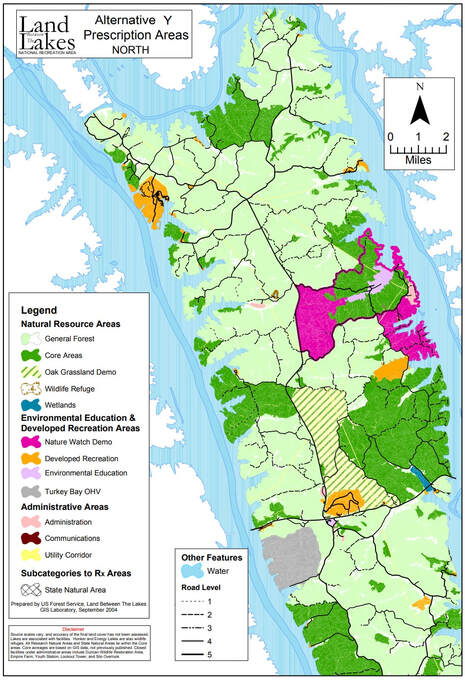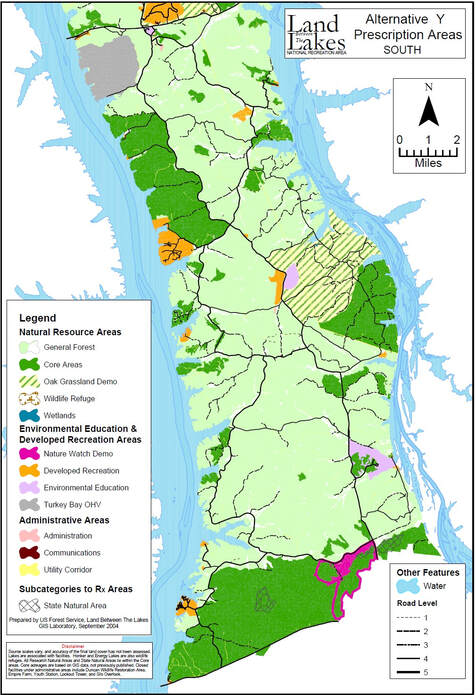The Core Areas: The Land Between the Lakes' Wild Country
One of the great underappreciated parts of the Land Between the Lakes National Recreation Area are the 42,000 acres of the Core Areas, the LBL's wild backcountry. Spread across the Kentucky and Tennessee parts of the forest, the Core Areas are products of the initial Wilderness study for the LBL conducted in the early 2000's (study linked here). They are vital remnants of forest that are meant to develop naturally over time to where they will take on the important characteristics of old growth forests. As our region lacks many forest areas like this, the Core Areas serve are important for a range of values from biodiversity to scientific research. The LBL's Land Resource Management Plan for the forest describes this importance:
.....provide a baseline control for long-term ecological research. These areas are protected and managed to perpetuate their rare or unique aVributes. Seven Core Area blocks range in size from approximately 2,500 to 11,000 acres, totaling more than 35,200 acres. Most of these larger tracts encompass entire watersheds. The remaining Core Areas fall in smaller blocks throughout LBL….
Old growth forests, now currently rare or missing from LBL, will develop over time and become much more common. Forest Core Areas will typically receive minimal active management. These areas will provide large blocks of undisturbed forest for old growth development, habitat for mature forest wildlife, opportunities for semi-primitive recreational experiences, and sefngs for environmental education. Two Tennessee State Natural Areas, located within Core Areas, will be managed in cooperation with the State of Tennessee. Core Areas may also serve as gauges or benchmarks in the monitoring and evalua>on of ongoing ecosystem management practices at LBL and in the region. In addition to Core Areas, smaller patches within the general forest will also be managed for development of old growth forest characteristics.
The Core Areas comprise approximately 42,000 acres designed to facilitate greater understanding of forest environments through collaborative research, administrative studies, and other working relationships. These areas serve as controls in comparative management land, in most cases…. And have little to no management disturbance. Core Areas provide remote, semi-primitvie recreational opportunities that have minimal impacts to ecological systems.
Many of our public lands in the East lack significant protected acreage as this. A trip to Core Areas like Devil's Backbone in Tennessee or Pond Hollow in Kentucky should be on any visitor's list!
.....provide a baseline control for long-term ecological research. These areas are protected and managed to perpetuate their rare or unique aVributes. Seven Core Area blocks range in size from approximately 2,500 to 11,000 acres, totaling more than 35,200 acres. Most of these larger tracts encompass entire watersheds. The remaining Core Areas fall in smaller blocks throughout LBL….
Old growth forests, now currently rare or missing from LBL, will develop over time and become much more common. Forest Core Areas will typically receive minimal active management. These areas will provide large blocks of undisturbed forest for old growth development, habitat for mature forest wildlife, opportunities for semi-primitive recreational experiences, and sefngs for environmental education. Two Tennessee State Natural Areas, located within Core Areas, will be managed in cooperation with the State of Tennessee. Core Areas may also serve as gauges or benchmarks in the monitoring and evalua>on of ongoing ecosystem management practices at LBL and in the region. In addition to Core Areas, smaller patches within the general forest will also be managed for development of old growth forest characteristics.
The Core Areas comprise approximately 42,000 acres designed to facilitate greater understanding of forest environments through collaborative research, administrative studies, and other working relationships. These areas serve as controls in comparative management land, in most cases…. And have little to no management disturbance. Core Areas provide remote, semi-primitvie recreational opportunities that have minimal impacts to ecological systems.
Many of our public lands in the East lack significant protected acreage as this. A trip to Core Areas like Devil's Backbone in Tennessee or Pond Hollow in Kentucky should be on any visitor's list!

